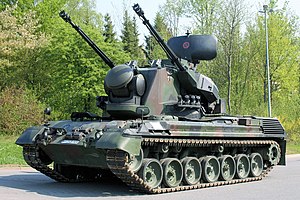This article needs additional citations for verification. (January 2013) |
| Flugabwehrkanonenpanzer Gepard | |
|---|---|
 Gepard 1A2 of the German Army | |
| Type | Self-propelled anti-aircraft gun |
| Place of origin | West Germany |
| Service history | |
| In service | 1976–present |
| Used by | See Operators |
| Wars | |
| Specifications | |
| Mass | 47.5 t (46.7 long tons; 52.4 short tons) |
| Length | Overall: 7.68 m (25 ft 2 in) |
| Width | 3.71 m (12 ft 2 in) |
| Height | Radar retracted: 3.29 m (10 ft 10 in) |
| Crew | 3 (driver, gunner, commander) |
| Armor | conventional steel |
Main armament | 2 × 35 mm Oerlikon GDF autocannon, each with 320 rounds anti-air ammunition and 20 rounds anti-tank |
Secondary armament | 2 × quad 76 mm smoke grenade dischargers |
| Engine | 10-cylinder, 37,400 cc (2,280 cu in) MTU multi-fuel engine 830 PS (819 hp, 610 kW) |
| Power/weight | 17.5 PS/t |
| Suspension | Torsion bar suspension |
Operational range | 550 km (340 mi) |
| Maximum speed | 65 km/h (40 mph) |
The Flugabwehrkanonenpanzer Gepard ("anti-aircraft-gun tank 'Cheetah'", better known as the Flakpanzer Gepard) is an all-weather-capable West German self-propelled anti-aircraft gun (SPAAG) based on the hull of the Leopard 1.[1] It was developed in the 1960s, fielded in the 1970s, and has been upgraded several times with the latest electronics. It has been a cornerstone of the air defence of the German Army (Bundeswehr) and a number of other NATO countries.
In Germany, the Gepard was phased out in late 2010 and replaced by the Wiesel 2 Ozelot Leichtes Flugabwehrsystem (LeFlaSys) with four FIM-92 Stinger or LFK NG missile launchers. A variant with the MANTIS gun system and LFK NG missiles, based on the GTK Boxer, was also considered.[2]
The Gepard has been widely used in combat in the Russo-Ukrainian War, mostly to shoot down drones.[3][4][5]
- ^ Tanks and armored fighting vehicles: visual encyclopedia. New York: Chartwell Books. 2012. p. 298. ISBN 9780785829263. OCLC 785874088.
- ^ "Der 'Gepard' hat ausgedient" [The 'Cheetah' has served its purpose]. KN (in German). 9 March 2010. Archived from the original on 31 March 2010. Retrieved 16 April 2010.
- ^ "Putin is Angry: Gepard 'Flakpanzers' Heading to Ukraine to Kill Russian Planes". 1945. 3 December 2022.
- ^ Cite error: The named reference
:2was invoked but never defined (see the help page). - ^ Cite error: The named reference
:3was invoked but never defined (see the help page).